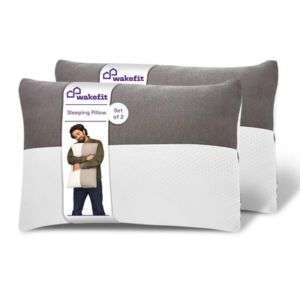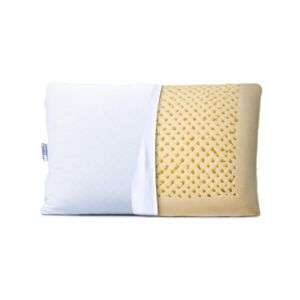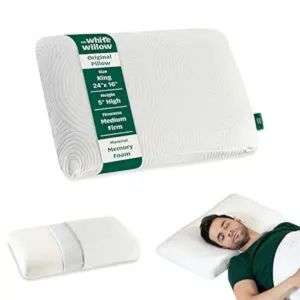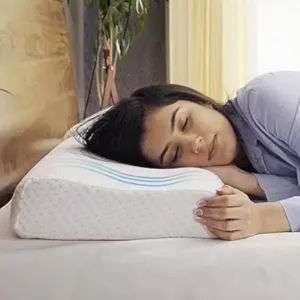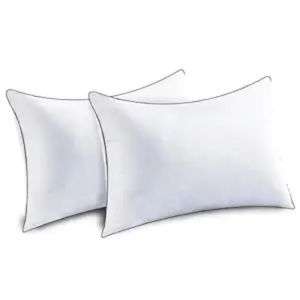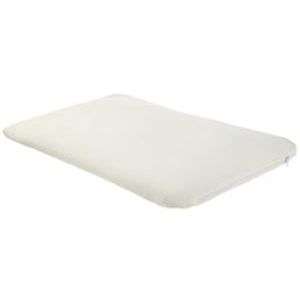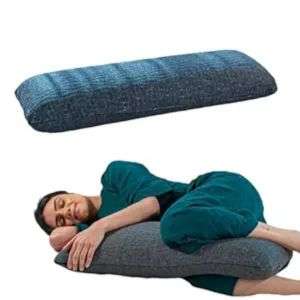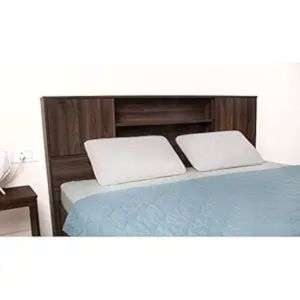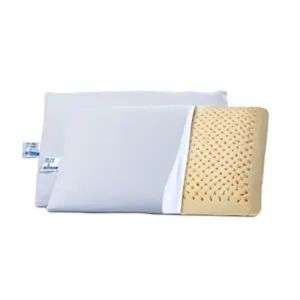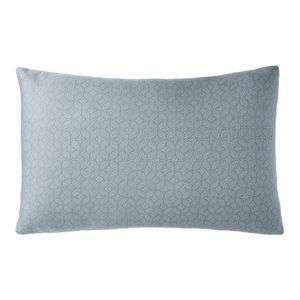
10 Best Pillows for Side Sleepers in India 2024
- Last Updated - 13/11/2024
- Best Overall
#1
4.5/5
Highlights
- Fill Type: Hollow Fiber
- Loft: Adjustable
- Firmness: Medium
- Shape: Rectangular
- Best Choice
#2
4.6/5
Highlights
- Fill Type: Natural Latex
- Loft: 6.3 inches
- Firmness: Firm
- Shape: Rectangular
- Best Combinations
#3
4.7/5
Highlights
- Fill Type: Memory Foam
- Loft: 5 inches
- Firmness: Medium-Firm
- Shape: Contour
- Best Choice
#4
4.5/5
Highlights
- Fill Type: Microfiber
- Loft: 12.7 inches
- Firmness: Soft
- Shape: Rectangular
- Best Cooling
#5
4.4/5
Highlights
- Fill Type: Down Alternative
- Loft: 5 inches
- Firmness: Soft-Medium
- Shape: Standard Size
- Best Choice
#6
4.3/5
Highlights
- Fill Type: Memory Foam (Gel Infused)
- Loft: 2 inches
- Firmness: Soft-Medium
- Shape: Thin Rectangle
- Best Choice
#7
4.6/5
Highlights
- Fill Type: Memory Foam
- Loft: 10 inches (Body Pillow)
- Firmness: Soft-Firm
- Shape: Long Rectangle (Body)
- Best Choice
#8
4.5/5
Highlights
- Fill Type: Memory Foam
- Loft: 5 inches
- Firmness: Medium-Firm
- Shape: Contour Shape
- Best Latex
#9
4.8/5
Highlights
- Fill Type: Natural Latex
- Loft: 4 inches (Medium)
- Firmness: Firm-Medium
- Shape: Contour Shape
- Best Choice
#10
#10
4.2/5
Highlights
- Fill Type: Microfiber Fill
- Loft: 5 inches (Standard)
- Firmness: Soft-Medium
- Shape: Rectangular
- Best Overall
#1
Highlights
- Fill Type: Hollow Fiber
- Loft: Adjustable
- Firmness: Medium
- Shape: Rectangular
4.5/5
- Best Choice
#2
Highlights
- Fill Type: Natural Latex
- Loft: 6.3 inches
- Firmness: Firm
- Shape: Rectangular
4.6/5
- Best Combinations
#3
Highlights
- Fill Type: Memory Foam
- Loft: 5 inches
- Firmness: Medium-Firm
- Shape: Contour
4.7/5
- Best Choice
#4
Highlights
- Fill Type: Microfiber
- Loft: 12.7 inches
- Firmness: Soft
- Shape: Rectangular
4.5/5
- Best Cooling
#5
Highlights
- Fill Type: Down Alternative
- Loft: 5 inches
- Firmness: Soft-Medium
- Shape: Standard Size
4.7/5
- Best Choice
#6
Highlights
- Fill Type: Memory Foam (Gel Infused)
- Loft: 2 inches
- Firmness: Soft-Medium
- Shape: Thin Rectangle
4.3/5
- Best Choice
#7
Highlights
- Fill Type: Memory Foam
- Loft: 10 inches (Body Pillow)
- Firmness: Soft-Firm
- Shape: Long Rectangle (Body)
4.6/5
- Best Choice
#8
Highlights
- Fill Type: Memory Foam
- Loft: 5 inches
- Firmness: Medium-Firm
- Shape: Contour Shape
4.5/5
- Best Latex
#9
Highlights
- Fill Type: Natural Latex
- Loft: 4 inches (Medium)
- Firmness: Firm-Medium
- Shape: Contour Shape
4.8/5
- Best Choice
#10
Highlights
- Fill Type: Microfiber Fill
- Loft: 5 inches (Standard)
- Firmness: Soft-Medium
- Shape: Rectangular
4.2/5
Other Tips for Side Sleepers
In addition to selecting a supportive pillow that promotes spinal alignment, side sleepers can use the following strategies for sleeping comfortably each night.
Choose the Right Mattress: The best mattress for side sleepers will provide ample cushioning to the shoulders and hips in order to align the spine and alleviate pressure in different areas. Most side sleepers on our test team prefer mattresses with softer feels that conform closely to the body without sinking too much beneath their heavier areas.
Use a Pillow Between the Knees: A pillow between the knees can also improve spinal alignment and reduce pressure in the lower back and hips. Pillows filled with down/feathers, shredded foam, and other moldable materials tend to be most comfortable. You may also find more comfort and pressure relief by placing the pillow beneath your legs.
Invest in a Mattress Topper: A topper is a single layer of cushioning material placed on top of your mattress. Toppers can measure up to 4 inches thick, so using one can make your mattress feel significantly softer or firmer. For side sleepers, the right topper can mean closer conforming, better spinal alignment, and less pressure.
Other Tips for Side Sleepers
In addition to selecting a supportive pillow that promotes spinal alignment, side sleepers can use the following strategies for sleeping comfortably each night.
Choose the Right Mattress: The best mattress for side sleepers will provide ample cushioning to the shoulders and hips in order to align the spine and alleviate pressure in different areas. Most side sleepers on our test team prefer mattresses with softer feels that conform closely to the body without sinking too much beneath their heavier areas.
Use a Pillow Between the Knees: A pillow between the knees can also improve spinal alignment and reduce pressure in the lower back and hips. Pillows filled with down/feathers, shredded foam, and other moldable materials tend to be most comfortable. You may also find more comfort and pressure relief by placing the pillow beneath your legs.
Invest in a Mattress Topper: A topper is a single layer of cushioning material placed on top of your mattress. Toppers can measure up to 4 inches thick, so using one can make your mattress feel significantly softer or firmer. For side sleepers, the right topper can mean closer conforming, better spinal alignment, and less pressure.
What Are the Key Differences Between Memory Foam and Down Pillows for Side Sleepers
When choosing a pillow, side sleepers often face the dilemma of selecting between memory foam and down pillows. Each type offers distinct advantages and disadvantages that cater to different preferences and needs. Here’s a detailed comparison of the key differences between memory foam and down pillows specifically for side sleepers.
Material Composition
- Memory Foam Pillows: Made from viscoelastic polyurethane foam, memory foam pillows are designed to respond to pressure and body heat, allowing them to mold to the contours of your head and neck. This provides personalized support, which is beneficial for maintaining spinal alignment during sleep13.
- Down Pillows: These pillows are filled with the soft under feathers of ducks or geese, known for their luxurious softness and lightweight feel. Down pillows offer a plush surface that can be fluffed to achieve the desired loft, making them comfortable but less structured than memory foam25.
Support and Comfort
- Support: Memory foam pillows are generally firmer and provide excellent support for side sleepers by cradling the neck and head. This support helps alleviate pressure points and can reduce neck pain, which is particularly beneficial for those who require more stability while sleeping13.
- Comfort: Down pillows are softer and more malleable, allowing them to conform quickly to the shape of the head. This can be appealing for side sleepers who prefer a softer feel. However, they may not provide adequate support over time as they compress more easily than memory foam23.
Durability
- Memory Foam: Typically more durable than down pillows, memory foam can last several years (up to three years or more) without losing its shape. They are resilient and tend to maintain their support over time12.
- Down: While down pillows can also last long (up to 10-15 years with proper care), they generally have a shorter lifespan compared to memory foam. They may require regular fluffing to maintain their loft and comfort level23.
Maintenance
- Memory Foam: These pillows often require spot cleaning or hand washing to prevent damage. They may also retain heat due to their dense structure, which can be uncomfortable for some sleepers, especially in warmer climates12.
- Down: Down pillows are usually machine washable, making them easier to maintain. However, they can be prone to allergens since they are made from natural materials, which could be an issue for allergy sufferers14.
Temperature Regulation
- Memory Foam: Traditional memory foam tends to trap heat, which may lead to discomfort for hot sleepers. However, many modern versions incorporate cooling gels or breathable materials to mitigate this issue34.
- Down: Down pillows are naturally breathable and can help regulate temperature well throughout the night. They provide warmth without causing overheating, making them suitable for various climates25.
What Are the Key Differences Between Memory Foam and Down Pillows for Side Sleepers
When choosing a pillow, side sleepers often face the dilemma of selecting between memory foam and down pillows. Each type offers distinct advantages and disadvantages that cater to different preferences and needs. Here’s a detailed comparison of the key differences between memory foam and down pillows specifically for side sleepers.
Material Composition
- Memory Foam Pillows: Made from viscoelastic polyurethane foam, memory foam pillows are designed to respond to pressure and body heat, allowing them to mold to the contours of your head and neck. This provides personalized support, which is beneficial for maintaining spinal alignment during sleep13.
- Down Pillows: These pillows are filled with the soft under feathers of ducks or geese, known for their luxurious softness and lightweight feel. Down pillows offer a plush surface that can be fluffed to achieve the desired loft, making them comfortable but less structured than memory foam25.
Support and Comfort
- Support: Memory foam pillows are generally firmer and provide excellent support for side sleepers by cradling the neck and head. This support helps alleviate pressure points and can reduce neck pain, which is particularly beneficial for those who require more stability while sleeping13.
- Comfort: Down pillows are softer and more malleable, allowing them to conform quickly to the shape of the head. This can be appealing for side sleepers who prefer a softer feel. However, they may not provide adequate support over time as they compress more easily than memory foam23.
Durability
- Memory Foam: Typically more durable than down pillows, memory foam can last several years (up to three years or more) without losing its shape. They are resilient and tend to maintain their support over time12.
- Down: While down pillows can also last long (up to 10-15 years with proper care), they generally have a shorter lifespan compared to memory foam. They may require regular fluffing to maintain their loft and comfort level23.
Maintenance
- Memory Foam: These pillows often require spot cleaning or hand washing to prevent damage. They may also retain heat due to their dense structure, which can be uncomfortable for some sleepers, especially in warmer climates12.
- Down: Down pillows are usually machine washable, making them easier to maintain. However, they can be prone to allergens since they are made from natural materials, which could be an issue for allergy sufferers14.
Temperature Regulation
- Memory Foam: Traditional memory foam tends to trap heat, which may lead to discomfort for hot sleepers. However, many modern versions incorporate cooling gels or breathable materials to mitigate this issue34.
- Down: Down pillows are naturally breathable and can help regulate temperature well throughout the night. They provide warmth without causing overheating, making them suitable for various climates25.
| Company | Memory Foam | Down Pillow |
|---|---|---|
| Material | Viscoelastic polyurethane foam | Duck or goose down feathers |
| Support | Firm support; molds to head/neck | Soft; conforms quickly but less support |
| Durability | Lasts 3+ years | Lasts 10-15 years with care |
| Maintenance | Spot clean; may retain heat | Machine washable; hypoallergenic options available |
| Temperature Regulation | Can trap heat (varies by type) | Breathable; good temperature regulation |
Conclusion
For side sleepers, the choice between memory foam and down pillows largely depends on personal preferences regarding firmness, support, and comfort. Memory foam is ideal for those needing firm support and spinal alignment, while down pillows cater to those who prioritize softness and a plush feel. Ultimately, understanding these differences will help you select the pillow that best meets your sleep needs.
